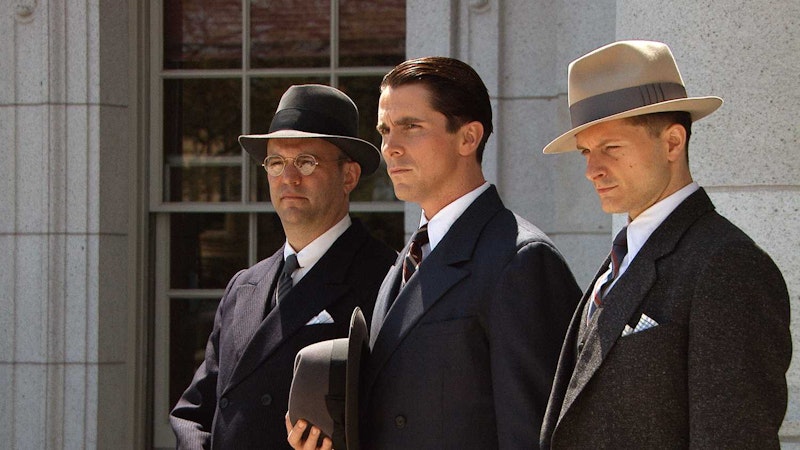There’s a precipice that filmmaking crossed over sometime in the late-2000s to get to where it is now. Part of it is fallout from the recession and changing consumer behavior leading to film distribution getting upended by streaming, part of it was not just advancements in digital technology but the acceptance of it as viable for both commercial and artistic enterprises. Many would place 2009 as the year it was decided that it changed, with Slumdog Millionaire the first film shot on digital to take home the Oscar for cinematography, and 11 months later James Cameron debuting his wholly computer-generated world of Avatar, which was the highest-grossing film of all time for almost a decade. Released squarely in the middle of these was a crime epic from Michael Mann, realizing the heartbeat of late-Depression-era bank robbers and the rapidly modernizing world of crime and crime fighting in high definition digital.
Public Enemies doesn’t have the feel of a period piece. There’s an acute attention to every detail in the film, and yet it never seems like that’s in service of the audience transported back to a golden era of cops and robbers. The details, if anything, are for the actors, allowing them to live and breathe 1933 as if it were the present. The film pulls off a magic trick that so many aspire to but so few achieve—it feels like the cameras are capturing something as they’re really unfolding. Not since Peter Watkins has a filmmaker so delicately constructed a historical reality to be realized on set. But unlike Watkins’ faux-documentary style, Mann’s is pure poetry, with his camera gliding around as if possessed by the spirit of Terrence Malick.
Dante Spinotti, Mann’s most frequent cinematographer, is armed here with bleeding edge HD cameras from the Sony CineAlta, which, since the turn of the millennia, had been the instrument of choice in pushing the visual boundaries of filmmaking. Mann, specifically, was interested in both digital’s workflow and its ability to render natural light, especially at nighttime. While it’s possible to achieve some similar effects with celluloid (and Mann was someone who achieved great artistic heights shooting nighttime on film), digital offers the ability for more improvisation with lighting conditions; it’s possible to get the faintest bit of nightly blue in the sky showing through a darkened wood on film, it’s just a lot easier on digital.
Criticizing the textural specificity of digital was always in vogue while some pushed for it as an alternative to the photochemical processes, but as the technology reached more parity with the resolving power of film, digital became more criticized for its lack of texture than anything. Now, a lot of filmmakers atavistically reach for 16mm for its rough grain, to add a texture often only for its nostalgic qualities. However, in 2009, even high definition digital had a roughness all its own. Steven Soderbergh talked in retrospect about using the prototype RED cameras on Che, and how there were certain kinds of images those early digital cameras created that just aren’t possible anymore with more modern tech. In Public Enemies, there’s often a blur or low-light artifacts that wouldn’t be rendered even on consumer grade digital cameras now, but it offers a beauty all its own. The digital strangeness of the pictures never really fades away, and is more severe at certain times than others as the cameras are pushed to the limit. It makes the content of this historical film feel stunningly modern.
At every step of the story, the world is changing. John Dillinger (Johnny Depp) is part of a dying breed of bank robbers as the “organized” part of crime really takes shape, and those trying to stop them are taking on a new “scientific” approach, spearheaded by J. Edgar Hoover (Billy Crudup) and his federal police force, the Bureau of Investigation. “We are in the modern age, we are making history. Take direct, expedient action. As they say in Italy these days, ‘Take off the white gloves.’” Hoover’s thinly-veiled fascistic approach collides with one of his top agents, Melvin Purvis (Christian Bale). Old-school and fancying himself as a more noble sort of lawman, Purvis might be as outdated as Dillinger’s cowboy bank robbing—they’re both 19th-century ideals trapped in the new and terrifying 20th century, a rapidly evolving technocracy of bureaucrats and administrators.
When they come to blows the digital realism of the film mixes with an elliptical editing style and crunchy sound design to create some of the most viscerally poetic sequences in Mann’s filmography. Up close their Thompsons explode as they spew fire and gas from their barrels, and then the shot will cut to distance where they pop pop pop before the bullets snap next to the camera. It’s a violent symphony of light and sound. The machinery recording and conveying it is more than just a tool, they are eyes and ears, and the experience of watching it is a kind of fusing of man and machine. During the most climactic gunfight in the film, Purvis finally catches up to Dillinger associate Baby Face Nelson (Stephen Graham), and runs him off the road. Nelson runs out of the crashed car as Purvis and his fellow G-men empty their weapons on him. As the bullets rip Nelson’s body apart, his Thompson furiously fires into the ground like a cry of death. As his last breath releases into the cold night, his gun smokes in the background. Public Enemies is as much a document of the time it was representing as it is an experience of the time it was made.

